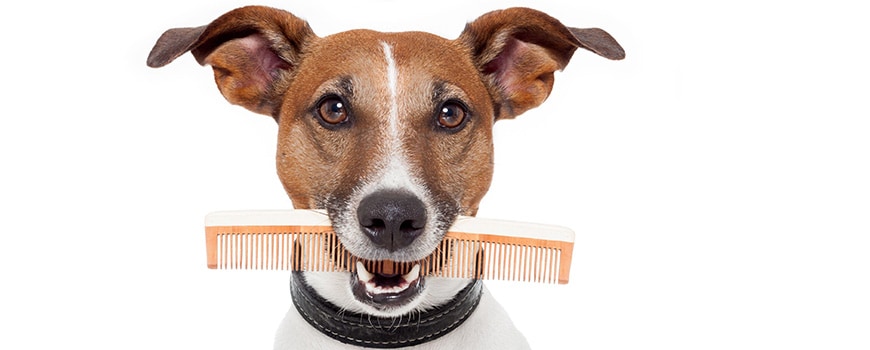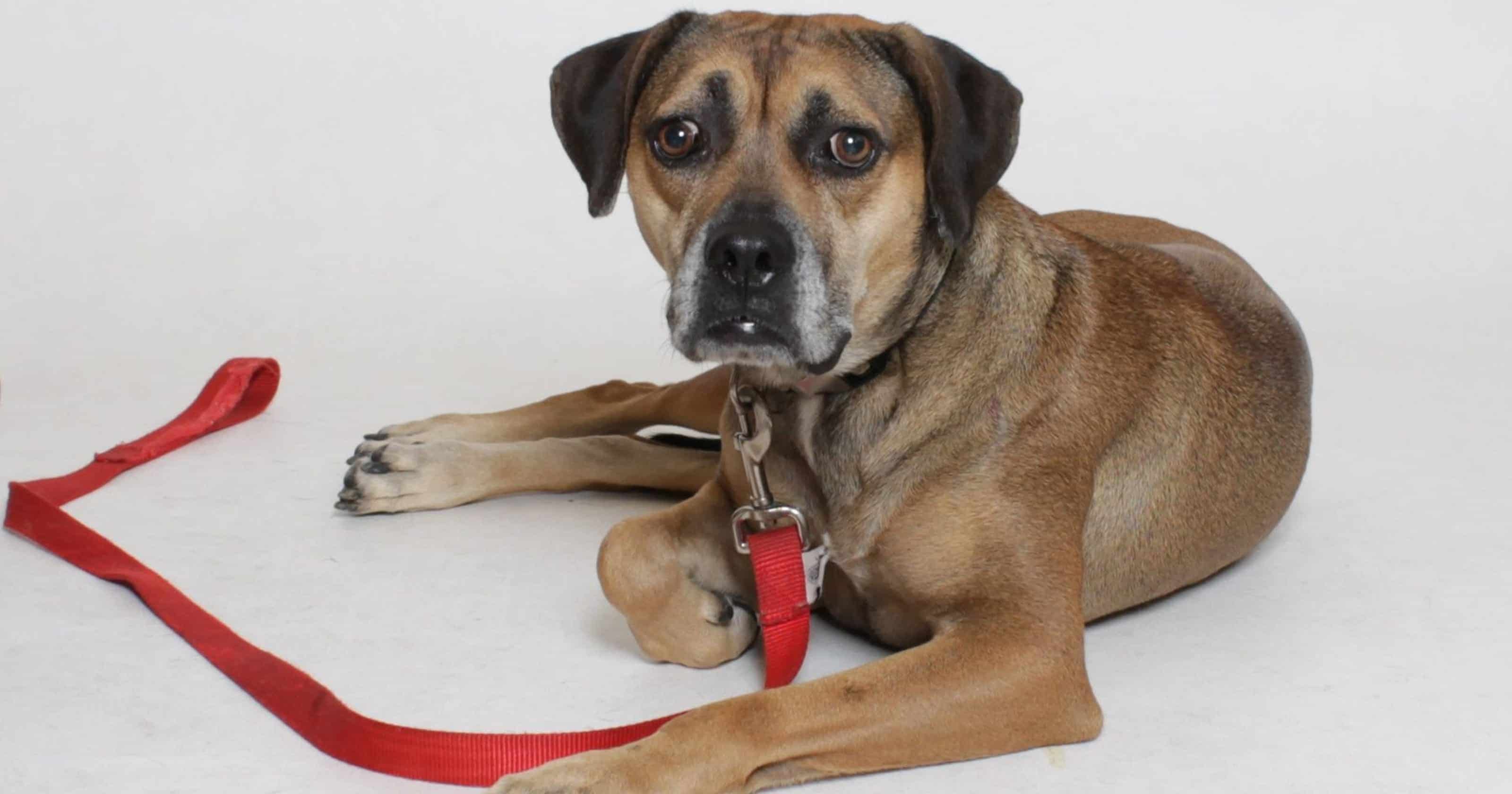Now let’s discuss what animals, and specifically dogs, look like when they are worried, anxious, or stressed while being groomed. Let’s start with some body-language descriptions. Beginning with a dog’s head, an anxious dog may have his ears pinned back, his mouth tight.
His lips may be pursed as well and perhaps also raised to show the canines. There might also be barking, or other vocalizations, such as growling, which serves as a warning sign prior to escalation. When a dog is preparing to bite, his teeth may be bared with his mouth puckered in such a way that the teeth are visible.
A dog’s brow might look furrowed. Anxious dogs might also pant excessively. You may note what are known as avoidance behaviors. For example, the dog might turn away to avoid eye contact or you might see the whites of his eyes as he looks in another direction.
When a dog is ready to fight or bite, his eyes may be fixed in a hard stare, or he might overtly look away. You might also observe the combination of both the body appearing stiff and the whites of his eyes showing at the same time.
A dog’s ears may be pinned back or flat and close to his head and he may seem to be backing away or leaning in the opposite direction. This behavior would indicate a frightened dog that could potentially bite if provoked. A dog’s mouth may suddenly shut and there may be rapid panting, lip licking, and/or drooling.
At the other end of the dog, you can watch for the dog’s tail carriage as an indicator of anxiety or stress. For most dogs, the tail carriage is easy to see; however, for some animals with cropped tails, this may be more difficult to discern.
Nevertheless, try to note where the tail is located as it can be a good indicator of a dog that is experiencing fear, anxiety, or stress. An anxious dog may have his tail between his hind legs. Or the tail may be standing up stiffly and erect in the air.
All the above-mentioned signs are important indicators of a dog’s overall mood. When a dog is ready to bite, any combination of these body language signals may be present. It’s also important to look at the dog’s overall body posture for signs of discomfort. Is the dog trembling? Is the dog pacing? Is the dog displaying a “frozen” body position? Or a “shake-off,” as if the dog is shaking off water (when he isn’t wet)?
Also, as you approach the dog, he may exhibit an overall body avoidance behavior which might look like he is backing away, or trying to hide by crouching down or curling up. Dogs may also express nervousness and a lack of comfort by lying on their backs and exposing their bellies.
While avoidance behaviors are often very obvious, there are other less obvious behaviors that also indicate stress, known as displacement behaviors, Displacement behaviors are any behaviors that occur out of context, and are simply ways in which a dog may communicate that it would like to “change the subject” when feeling uncomfortable.
Examples of displacement behaviors include yawning when not tired, panting when there’s no exertion, shaking off when completely dry, or licking lips when no food is present. Other displacement behaviors you may observe could be scratching, tongue-flicking, sneezing, yawning, blinking, turning away, or sniffing the ground. Indicators of this type of anxiety might also include urinating or defecating.
Again, all the above signs, occurring individually or in combination, will often indicate the degree of stress that a dog is experiencing.
Once you are better able to recognize these signs, you can attempt to address the cause of the stress and treat it accordingly. As noted, there are varying degrees and many different manifestations of stress. Learning to become aware of a dog’s stress signals can help greatly in preventing a dog’s anxiety from escalating, can save you time in the long run, and certainly can help to avoid injuries to both you and the dog.
Sometimes stress is a good thing because it enables a dog to learn. Moderate stress builds resilience. Extreme stress, however, may make it very difficult to groom a dog as it increases the amount of cortisol, serotonin and other neurotransmitters that trigger the fight or flight mechanism. This difficulty can cause the dog to immediately learn that the grooming shop, grooming table, and groomer are things to avoid at all costs.
Thus, generally speaking, once you learn what anxiety looks like, you want to work toward avoiding situations that cause the dog’s anxiety to escalate, as there might be dangerous results that could include you being bitten, and/or the dog’s getting injured. The better you become at recognizing stress, the more you will be able to differentiate between quickly changing scenarios.
Sometimes a dog may bark or growl in a playful way. However, at other times he might bark or growl as a warning or threat. Signs of stress could occur as isolated events or in combination. Learning how each individual dog is feeling at a particular time throughout the grooming process–by understanding and recognizing the signs–will allow you to alter your grooming plan them before the situation deteriorates.
This will enable you to make the process safer and more comfortable for everyone.
TIP: Taking some additional time to help all dogs–but especially a fearful dog–feel comfortable will go a long way toward building trust and confidence in you and your shop. If a fearful dog arrives at your venue, an example of a strategy that you can use to start off on the right paw is to play the “on and off’ game.
The fearful dog on the grooming table: The “on and off” game
To begin, start by putting the dog on the table, treating, and then taking the dog off the table. If at all possible, allow the dog to get on and off the table unassisted. Repeat this series a few times in a row, and then allow the dog to take a break and walk around the room a bit.
Keep repeating this process, gradually extending the time that the dog stays on the table. The individual temperament of the dog will determine how long you are able to play this game. You will want to stop before the dog becomes anxious, so try to go through the series (on/off) a few times in a row, and finish on a positive note.
Stationing comfortably on the grooming table is a critical skill for any dog, especially a frightened one. This is where observation skills come in very handy. Remember, it is always better to stop before pushing the dog over his threshold. If it’s needed, consider doing this exercise in two, separate, short sessions.
Continue to play the “game” until you perceive that the dog is beginning to like it. Be sure to pair high-value treats with this activity throughout the game. Once things are going well, consider finishing up the game. You always want to quit while you’re ahead!
When the dog will stand comfortably on the table without trying to move away or get off the table, it’s time to start to reinforce standing still.

